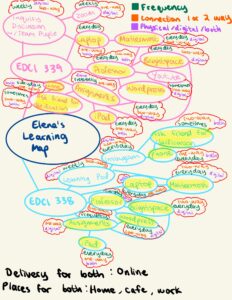The following course Course Outline 2021 was redesigned using the Universal Design for Learning (UDL) guideline framework (Meyer et al., 2014).
Redesigned Learning Objectives and Assessment Format Incorporating UDL
Any time a student has to present what they have learned, they should present information relevant to the course and that they find interesting. The representation of learning can be in any way they choose, it could be audio, visuals, writing, or another format the student deems suitable and effective. Allowing the students to present what they find to be interesting and relevant, gives a stronger sense of autonomy and additionally increases interest and motivation, thus efforts put forth.
The student should be given adequate time to complete any tasks, while also having guidelines set in place to promote meeting expectations and to allow the student to develop learning strategies. Another benefit of allowing the students to represent their knowledge in any format of their choosing ensures inclusivity for different skill sets and learning methods.
Students may select peer-reviewed resources themselves and/or they may ask the professor for suggestions. Finding effective resources on their own can enhance comprehension and promote student autonomy. Additionally, asking the professor for suggestions enhances learning how to be guided through information.
By the end of the course, students should practice expressing their learning and knowledge using multiple different forms of media and multiple different cited sources. They should have the opportunity to use any technology tools for presenting information they choose and they are allowed to ask for professor recommendations on tools.
The specific goals of the course should be met by all coursework being completed and presented using the tools of their choosing.
Incorporating these changes to the course learning objectives and assessment formats ensures the UDL guidelines are being followed thus optimizing learning.
To summarize,
Giving students the choice of what tools, resources, and formats they are using fosters interest, thus increasing effort and motivation. Ensuring there are still guidelines and expectations in place teaches self-regulation and strategies. These changes all follow the UDL engagement guideline.
Furthermore, giving students the chance to choose various tools and media formats to utilize allows them to practice different ways of presenting their knowledge and how they want to represent it. The opportunity to receive professor recommendations on helpful resources and tools can help enhance comprehension, and this all contributes to the UDL representation guideline.
Finally, allowing freedom of formatting allows the student to vary the tools and methods of response used, as well as allowing using different media for communication. Having deadlines and expectations in place encourages the students to set goals and timelines and this all contributes to the action and expression UDL guideline.
Required Readings
Required course readings should ensure accessibility by providing the reading options along with visuals, optional supplemental information, and audio.
Audio & Visual Recording
Permitted with permission from the professor, this is a helpful option for students with different learning needs.
I chose this activity because revising a course I was already very interested in and found to be quite well-run with a UDL framework approach showed me just how effective these methods could be to benefit a course. Incorporating a UDL approach to the course outline before my taking it would have optimized my interest, motivation, and efforts while also teaching me to set goals and utilize the various tools at my disposal. Although I found the course to be very engaging and educational, I believe utilizing more online tools and being allowed to choose my format for assessments would have expanded my skillset regarding the material and taught me a greater sense of autonomy. I chose this activity to develop what I deem to be effective methods for learning while still meeting course expectations and getting the opportunity to use many tools and resources. This aligned with my learning goals of broadening my views on flexible and personalized learning methods that are still effective and making use of all the tools currently available to students. In changing this course outline I learned that there are generally not many alternate options for students to explore for assessments, readings, and meeting course objectives, however, giving the option for students to personalize their learning could be beneficial for students to gain valuable skills.
References
Meyer, A., Rose, D.H., & Gordon, D. (2014). Universal design for learning: Theory and Practice. Wakefield, MA: CAST Professional Publishing.
